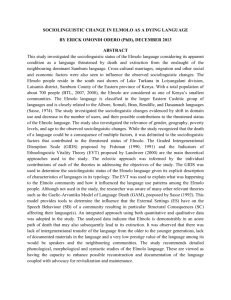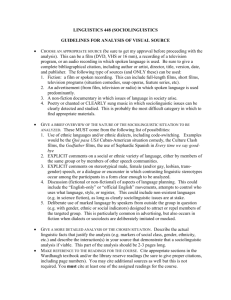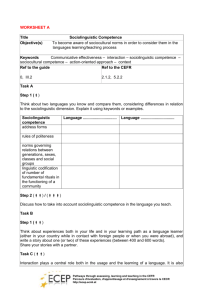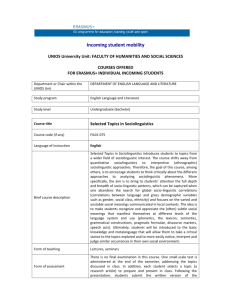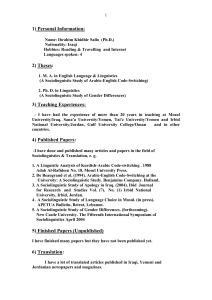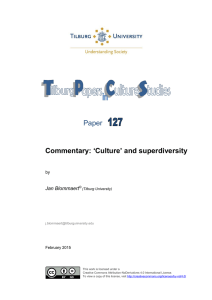Paper Supervernaculars and their Dialects Jan Blommaert
advertisement
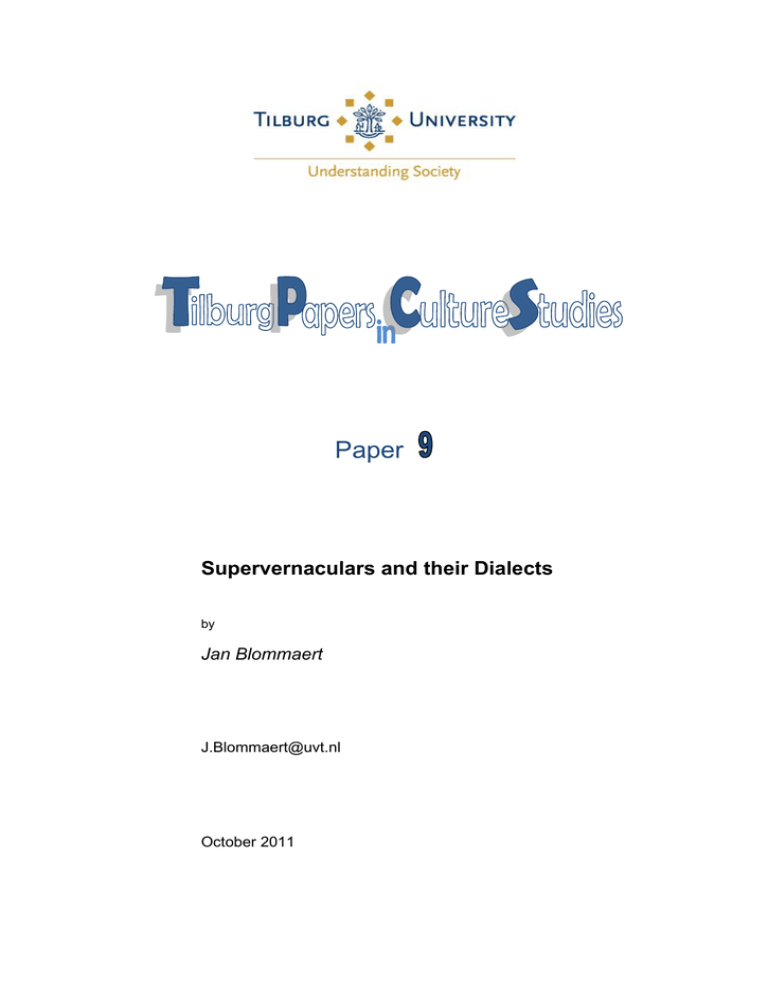
Paper Supervernaculars and their Dialects by Jan Blommaert J.Blommaert@uvt.nl October 2011 Supervernaculars and their dialects Jan Blommaert Abstract This paper introduces the term ‘supervernacular’ as a descriptor for new forms of semiotic codes emerging in the context of technology-driven globalization processes. Supervernaculars are widespread codes used in communities that do not correspond to ‘traditional’ sociolinguistic speech communities, but as deterritorialized and transidiomatic communites that, nonetheless, appear to create a solid and normative sociolinguistic system. Such systems – we illustrate them by referring to mobile texting codes – can be seen as the outcome of complex processes of englobalizationand-deglobalization, of globally circulating affordances that always and inevitably get taken up within the possibilities and constraints of local sociolinguistic economies. Consequently, they only occur as ‘dialects’ of the supervernacular: instances of locally constratined and ‘accented’ realization that display an orientation to the ideological ‘standard’ supervernacular. Investigating supervernaculars, seen from this angle, illustrate and clarify fundamental sociolinguistic processes of ‘standardization’ and shed light on the cultural dynamics of superdiversity. Key words: globalization, superdiversity, supervernaculars, mobile phones, texting 2 Supervernaculars and their dialects 1. Introduction This paper is part of a broader attempt at formulating a new and more accurate vocabulary for describing and understanding language in superdiversity (see Jaquemet 2005, Jörgensen 2008; Creese & Blackledge 2010, Rampton 2010, Sharma & Rampton 2011; Otsui & Pennycook 2010, Juffermans 2010, Blommaert 2010, Blommaert & Rampton 2011; Blommaert & Backus 2011, Blommaert & Varis 2011 for related work; Vertovec 2007 provides the broad framework for the exercise).1 The motive for this attempt is the growing awareness that globalization and its superdiverse outcomes generate considerable conceptual difficulties: an older theoretical and methodological vocabulary, building on an imagery of stable, resident and non-dynamic communities using languages, lacks both the empirical accuracy and the analytical clarity required for addressing the often messy and incomplete phenomena we witness and try to address. What is needed is a vocabulary that underscores, and allows us to imagine, the sociolinguistic world as made up of dynamic, mobile, unstable, yet ordered processes and phenomena, messy and unpredictable at the surface but understandable at a deeper level. This paper will engage with the notion of ‘supervernacular’ – a type of sociolinguistic object which, when developed empirically, can lead to quite radical reformulations of cultural processes and transformations in the age of globalization and superdiversity. Supervernaculars, as we shall see, are a particular and new type of sociolinguistic object: semiotic forms that circulate in networks driven, largely, by new technologies such as the Internet and mobile communication devices. Attention to these new forms can highlight, because of their extreme clarity, some fundamental aspects of sociolinguistic processes, notably those aspects we capture under terms such as ‘standardization’ (cf Agha 2007; Silverstein 1996; Makoni & Pennycook 2007; Dong 2010). An important part of the work reported in this paper is speculative and rests on the powers of imagination; it is definitely work in progress intended to be explored and tested before it can claim vailidty. It is one of the attractive characteristics of the present era – an era of 1 This attempt is the core agenda of the Max Planck Sociolinguistic Diversity Working Group affiliated to the Max Planck Institute on Ethnic and Religious Diversity, Göttingen. I am indebted to the members of the Working Group (Karel Arnaut, Ben Rampton, Jens-Normann Jörgensen, Sirpa Leppänen, Angela Creese, Adrian Blackledge, Marilyn Martin-Jones, Rob Moore, Cécile Vigouroux, Roxy Harris, Martha Kjaerrebaek, Max Spotti, Dong Jie, Sjaak Kroon, Ad Backus, Piia Varis, David Parkin) for input without which none of the ideas articulated here would have emerged. 3 theoretical and methodological confusion, some say – that speculative and explorative work is not just needed but also welcomed. And new images –an other word for theoretical speculation – are permanently required if sociolinguistics wishes to avoid a crisis of imagination, visible whenever old frameworks are projected onto fundamentally new phenomena and processes. I will begin by designing the contours of the phenomena we could address by means of the term ‘supervernacular’, and emphasize that in actual empirical reality such supervernaculars only appear as dialects. I will illustrate this briefly by means of some examples from mobile phone texting, and move on to sketch some implications. 2. Supervernaculars Globalization has generated social, cultural and linguistic superdiversity: an increasing fragmentation and diversification of patterns of conduct previously described in terms of generalizing categories (Vertovec 2007, 2010). Cultural forms such as patterns of language use, language choice and language mixing, can no longer be unquestioningly attached to stable, resident and (partly) homogenous communities – the old sociolinguistic notion of ‘speech community’ is very much in question nowadays (see Rampton 1998 for an early critique). We now observe new – or previously unnoticed – patterns of sociolinguistic distribution in which certain specific sociolinguistic resources are adopted by communities of users that share non of the traditional attributes of speech communities – territorial fixedness, physical proximity, socio-cultural sharedness and common backgrounds. People now use similar sociolinguistic resources without sharing any of these traditional features of community. And such loose, elastic, dynamic and deterritorialized communities are among the key features of superdiversity. The Internet and mobile communication devices such as mobile phones have of course been the driving forces behind such patterns of distribution, as they enable people to enter into (often intense) contact with interlocutors they will never physically encounter and whose cultural, social and linguistic backgrounds may be literally worlds apart. An online game such as World of Warcraft (http://eu.battle.net/wow/en/) reports an estimated 300 million online players spread over all parts of the world. Players from Western Europe can play with or against players from Brazil and India, using a standard set of (English-based) game and chat codes, a register for organizing the collective activities online, and modes of social conduct and learning practices specific to such online, long-distance collective activities (see Leppänen 2007; Leppänen & Piirainen-Marsh 2009). 4 Thus, the lack of shared backgrounds at one level does not prevent an elaborate sociolinguistic system to evolve among them at another level, and intense, sustained and creative patterns of communication to develop among them. We can call such new deterritorialized yet real communicative communities ‘supergroups’. The specific sociolinguistic resources they share and deploy can be called ‘supervernaculars’.2 Such vernaculars have all the features we commonly attribute to ‘languages’; yet sociolinguistically they operate in a very different way, not predicated on the traditional connections between languages and speech communities described earlier, and determined (in the strictest sense of the term) by new information and communication technologies.3 They are, in Jacquemet’s (2005) terms, transidiomatic and deterritorialized sociolinguistic resources. One supervernacular that immediately appears to offer itself for such description is, of course, English – the ‘language’ that dominates the global circulation of texts and messages through the Internet. But we have to be specific about this. The so-called ‘world Englishes’ we now observe in an ever-growing literature can in actual fact be seen as dialects of a supervernacular. The supervernacular is an imagined standard of ‘English’, and the dialects are the actually occurring ‘world Englishes’: specific local or regional realizations of English, tied to and embedded in local and regional sociolinguistic economies and emerged out of processes that bear all the features of dialects. This, we can say, is a simple terminological issue in which we suggest a particular vocabulary for addressing ‘World Englishes’. But more fundamental – and this is the specific point we need to establish here – is the fact that ‘English’ as such never occurs: the ‘English’ actually used across the world is always English moulded into a genre, a style, a register. ‘Actually occurring English’ is always a little bit of English, and this little bit will always bear the traces of its sociolinguistic deployment: it will always be accented, and always targeted at a particular audience, a function, a possible uptake; and it will always occur within the affordances and constraints offered by the local sociolinguistic economies in and across which which it circulates (cf Blommaert & Rampton 2011). Thus, the English used by the young Finnish gamers reported in Lepännen (2007) and Leppänen & Piirainen-Marsh (2009) is a highly specific, and 2 The term and its underlying rationale have to be credited to Karel Arnaut, who developed it in correspondence with several members of the Max Planck Working Group in early 2011. It was first used in writing by Wang & Varis (2011) and Velghe (2011). Observe that the ‘super’ in ‘supergroups’ and ‘supervernaculars’ if of a different order than that in ‘superdiversity’. While ‘super’ in the latter stands for ‘hyper’, i.e. a degree higher than that encountered before or elsewhere, the ‘super’ in ‘supergroups’ and ‘supervernacular’ is an equivalent’ of ‘trans-‘ and refers to communities and semiotic complexes whose composition and circulation transcend those of other semiotic complexes. I am grateful to Alastair Pennycook for pointing out this important difference. 3 5 specialized, code which reflects globalizing origins – the code was developed by the game developers for transnational, global usage – as well as the local conditions under which it can be deployed and make sense to its users. In that sense, it is not ‘English’ – the language-thathas-that-name – that operates as a supervernacular; the supervernaculars are the myriad of actually occurring specialized little bits of English, encapsulated in and conditioned by the local sociolinguistic economies in which they appear. The important point is to realize that supervernaculars only occur as dialects. Hence the ‘vernacular’ in the term. There is no ‘real’ supervernacular, other than the dynamic complex of emerging, stabilizing and changing dialects we actually observe, hear, speak, read and write. The supervernacular itself is indeed like ‘language’: an imagined, ideological object we commonly call ‘standard’ and to which all of us orient whenever we use the (real) ‘language’ (Silverstein 1996). The usage of this ‘language’ is a never-ending process of ‘enregisterment’ which never actually yields a stable and shared ‘register’. We never see or hear a finished register, we can only observe processes and practices of enregisterment (cf Agha 2007; Dong 2010). Like ‘language’, it is best to understand ‘register’ as an abstraction referring to the imagined stability of sociolinguistically ordered resources. In the case of English, it is a commonplace that merits repetition: we never hear ‘standard’ English, we always hear ‘English with an accent’, inflected and dialected English – the ‘accentless’ standard is evidently an accent among others. Yet, in all the myriad actual forms assumed by ‘English’, we see users orienting towards an ‘accentless’ norm – towards the imaginary neutrality of ‘normal’ usage of that specific code, the ‘best possible’ recognizable variety. This occurs even in contexts where clear and unambiguous standard codes are dominant and where users consciously and deliberately deviate from these standards. We shall see that such perceived deviations – anti-normativities – are actually just deviations at one particular scale level, and that they develop and derive their effectiveness from close observation of another set of (often quite rigorous) norms at another scale level. Subcultures react and rebel against the dominant culture and its norms, but they have their own strict norms. The term ‘standard’ can thus only stand for the idealized object as well as for the observable dynamics through which people orient towards this ‘standard’ (processes of ‘standarding’, if one wishes). We believe we observe globalization processes whenever we encounter ‘English’ in various parts of the world. We do indeed encounter globalization, because what we see is en-globalized forms, semiotic forms (such as the gaming codes) that were at some level prepared to go global, so to speak.4 But when we look at their actual deployment, we Ben Rampton provoked this important precision, and the term ‘englobalization’ is his creation. I gratefully acknowledge his suggestion here. 4 6 can see them only through the actual phenomenology of de-globalization – the instant localization of globally distributed resources, the instant adjustment of resources to locally valid economies of material and symbolic resources, the instant ‘accenting’ or ‘inflecting’ of globally circulating resources (cf Pennycook 2010; Blommaert 2008, 2010). Globalization is an abstract process; the interplay of englobalization and deglobalization is the realistic phenomenology of globalization, the really occurring ‘stuff’ of globalization, the actual object of inquiry. I propose to see the processes of ‘languaging’ described by Jörgensen (2008) and others as such processes of englobalization and deglobalization, in which resources from any part of the complex local repertoires are being mobilized and deployed in meaning-making; Otsui & Pennycook’s ‘metrolingualism’ (2010) and Rampton’s ‘contemporary urban vernaculars’ (2010) can be seen as the outcomes of such processes. In each of these cases, the actual semiotic forms we observe are the outcome of an interplay between global circulation – englobalization – and local deployment – deglobalization. The implications of this are quite important, and I will return to them towards the end of this paper. Making this distinction between an imagined, normative standard and actual dialectal realizations of it enables us to include the crucial language-ideological features of the processes we intend to understand here. We can now see actually occurring semiotic forms as locally deployed resources, ordered in relation to an ideological target – the ‘standard’, the ‘accentless’ variety. The constraints imposed by users’ place in the local sociolinguistic economies will determine the ways in which this orientation to an ideological standard is perceived as more-or-less ‘normal’. This is why we see that users’ performance can be appraised as those of novices, apprentices, ‘wannabes’, ‘almost-there’s’ or ‘experts’, and why we see the continuous evolving of complex and demanding learning and acquisition processes. The Congolese grassroots writers whose texts are central in Blommaert (2008, see also Juffermans 2010) displayed a distant awareness of a desired genre; they had a normative target, a kind of ‘standard’ to which their writing practices were oriented, and we could see how their writing practices displayed a sequence of increasing generic tightness – of learning the genre. But the local constraints of their literacy environment obstructed a realization of this genre likely to be perceived and understood as ‘fluent’ or ‘adequate’ by their European elite addressees. These constraints were shown to be systemic and not individual: they were constraints of a local/regional economy of literacy resources which positioned them, as individual writers and subjects, in the margin of the global economies of literacy. Thus, whenever we use our semiotic resources, we display our position in the sociolinguistic 7 economies in which we deploy them; and so, in the same move, we begin to catch a glimpse of the nature and structure of such sociolinguistic economies – a point forcefully made, of course, by Bourdieu (1991) as well as by Bernstein (1971) and Hymes (1996). Let us now apply these insights to one of those small bits of language that appear to behave very much in the ways specified above: massive distribution over large but not traditionally connected communities of users, and determined by new communication technologies. 3. A small supervernacular: mobile texting codes One mini-language that can be described as a supervernacular is the widely used set of codes for composing mobile phone text messages. These codes have emerged along with the generalized spread of mobile phones to all (even the most remote and marginal) corners of the world (see Velghe 2011 for an insightful account of its use in townships around Cape Town). They have followed the pace of the technological and ergonomic development of the mobile phones themselves as well as of the economy that carries their use along: the abbreviations and acronyms characterizing mobile texting codes originally reflected the clumsy, multipunch keyboard writing practices required for forming letters and symbols, as well as the relatively high cost of sending long messages. These ergonomically and economically constrained origins yielded a system which has survived technological developments that made keybord writing easier, as well as economic ones that made texting cheaper. It is useful to note that texting code is often perceived as ‘anti-writing’, and quite commonly identified as a scapegoat whenever teachers and authorities bemoan the perceived decline of (standard) writing competences. The texting code is indeed a form of hetero-graphy (Blommaert 2008) and thus a violation of ortho-graphy – the norms of writing that dominate higher scale levels such as those of the nation-state and/or the formal education system. Mobile texting codes are very much like a miniature ‘language’: we see in many places of the world similar englobalized patterns of formation of symbols, an emerging common vocabulary, and, of course, the deglobalization processes resulting in dialects of the supervernacular. Let us have a closer look at this mini-language. 3.1. The mini-language We see a limited number of symbols that have acquired a vast distribution over and beyond linguistic and cultural borders. What follows is a tentative list of these symbols; indepth descriptive work should be able to establish a more conclusive set. Although most of the symbols have their origins in English, they are used far more widely and very often in conjunction with symbols derived from other languages. 8 @ At 2 To, too 4 For 8 -eight, -ate, -ait B Be C See U You Thxs Thanks Msg Message Tmrw/2mrw Tomorrow Nth Nothing Sth Something Grz Greetings Bck Back Btr Better Wry Worry Fwd Forward ;-) :-x etc 3.2. Linguistic rules We notice that a large number of these symbols are ‘abbreviations’ in which the distinctive consonants of words and expressions take the upper hand. This pattern of skeletal abbreviation can be productively deployed in the creation of new and more specialized symbols: think of ‘LOL’ (‘laughing out loud’), or ‘POS’ (‘parents over shoulder’). 9 Some of he symbols are productive and can be combined with others in compound expressions. In such combinations, we see a regular morphosyntactic pattern. The symbol ‘8’, for instance can be combined with others so as to form regular inflected nouns and verbs, and the rules of such formations in ‘real’ language are respected. Thus ‘w8’ stands for ‘wait’ or ‘weight’, ‘l8’ for ‘late’, ‘h8’ for ‘hate’, and ‘I 8’ for ‘I ate’. Similarly, ‘b4’ stands for ‘before’, ‘ur’ for ‘your’ and so forth. An acoustic image of (often vernacularized) pronunciation appears to determine the structure of such expressions. Note that the linguistic rules are complemented by strict graphic rules. The relatively simple processes of abbreviation appear to open up a space of unlimited variation; in actual fact, we observe strict rules of writing here allowing only very limited improvisation. On the basis of this language we can form new kinds of ‘sentences’ such as: Lkn fwd 2 C U @ 4 @ Urs (‘looking forward to see you at four at your place ’) If we would change one element in this written ‘sentence’ – if we defy the graphic rules of this mini-language, in other words – the expression becomes meaningless, as in: *Lkn fwd 2 S U @ 4 @ Urs Thus, while mobile texting code appears at first sight as an infintely creative space of practice allowing unrestricted freedom to experiment and free-wheel (and while the code is very often seen as an anti-orthography, especially by teachers and parents of young intensive users of the code), it is important to see that the code is strongly normative; it is – like any other form of language use – a system, something that operates on the basis of quite rigorously applied rules, deviation of which is possible but never unlimited and always comes with a price. It is, in effect, a subcultural ortho-graphy, an orthography at the subcultural scale and a heterography at the higher institutional scale. In spite of this – or precisely because of this – the code enables people to construct complex and delicate messages and entertain equally complex and delicate forms of interaction. 3.3. Sociolinguistic rules The code is not just a linguistic system; it is a sociolinguistic system as well. The use of this code is also tied to sociolinguistic rules of appropriateness and to orders of indexicality: using the code more or less expertly conveys pointers towards social identities (‘cool’, ‘nerd’ etc) as well as indexical signs as to message content and tone (‘angry’, ‘happy’, ‘funny’ etc – the emoticons play an important role in this of course). One cannot use this code everywhere and all the time. It is strongly dispreferred, for instance, in school assignments or other formal genres of writing (it would, thus, not always be welcome on a written CV). Knowledge of the 10 linguistic rules is combined with knowledge of the sociolinguistic rules and leads to a stratified indexical system of ‘good’ versus ‘less good’ versus ‘poor’ expressions done by people who are placed in roles ranging from ‘novice’ and ‘apprentice’ to ‘expert’ and ‘teacher’.5 Thus, wile we saw that texting codes represent a (heterographic) violation of (orthographic) norms at a higher scale level, they also appear to adhere to strictly formulated norms at another (subcultural, we can say) scale level. We do observe rigorously ordered indexicalities here. They occur, therefore, in a communicative environment which is polycentric and while they have validity in relation to one center – the subcultural center – they are denied legitimacy in relation to another one – that of the nation-state or the formal education system. Their normativity, orderliness and affordances are socially, culturally and politically niched. 3.4. Dialects of the supervernacular As said, we can observe the supervernaculars only through their local, dialectal realizations: processes of blending and mixing the ‘global’ resources with locally generated, recognizable and valid resources, forms of code-mixing which obey the basic orthographic and morphosyntactic rules specified above. The global resources are thus localized, and the global supervernacular becomes, locally and within certain niches, an instrument for small-group communication, often hermetic to outsiders (such as teachers and parents of young users). With this in mind, we can have a look at some samples from two dialects. 3.4.1. Dutch colloquialization The supervernacular is used in the sense described here among Flemish-Belgian, Dutchspeaking young people. We see two coordinated processes here: (a) the rules of the supervernacular are adopted along with part of its core vocabulary – this is the ‘englobalization’ aspect of the formation of the code; (b) they are applied to and blended with local vernacular language into a dialect – the ‘deglobalization’ aspect of the process. Consider the following examples. Code symbol Vernacular speech Standard Dutch English W8 Wacht (w-acht) Wacht Wait Velghe’s fascinating (2011) paper documents the process of learning such a local code in the context of ethnographic fieldwork, and makes several important methodological points in doing so. The researcher of such codes is perpetually an apprentice. 5 11 Z8 Zacht (z-acht) Zacht Soft L8 Lacht (l-acht) Lacht Laughs W817 Wacht eens even (w- Wacht eens even Wait a minute acht-één-zeven) Msch misschien Misschien Perhaps Gete geten Gegeten Eaten Ff Effe (‘plural of ef’) Even A while Kga ‘k ga Ik ga I’m going Kgonete ‘k gon ete Ik ga eten I’m going to eat We can see how the affordances of the supervernacular system are being adjusted to a local, dialect-using sociolinguistic economy; the supervernacular, thus, here generates strictly local/regional messages. That such messages exploit every available resources can be made clear from the following example, in which a young girl from Antwerp, Belgium expresses her love for her boyfriend (also from Antwerp): U R my 3M: ‘you are my dream’ The girl here writes in English; interestingly though, the mechanisms of the code permit her to code-switch from English into Dutch and back, so that the outcome is English with an Antwerp accent. The symbol ‘3’ stands for Dutch ‘drie’ (‘three’). ‘3M’ thus becomes ‘driem’, which comes close to the English word ‘dream’ pronounced with the rolling ‘r’ of Antwerp Dutch.6 3.4.2. Finnish-English texting The following set of examples from Finland illustrates how the rules of the supervernacular can be exploited by expert users in such a way that it generates playful, ironizing messages in which the Finnish accent in spoken English is rendered in texting code. This is partly 6 I obtained these samples from my son Frederik, whose efforts in educating his apprentice father are hereby gratefully acknowledged. 12 achieved by ‘eye dialect’ writing, partly by using elements from Finnish standard orthography.7 Lavli! Til tomorou ten! (“lovely! Till tomorrow then!”) sii juu! (“see you!!”) Häv ö seif flait tu joor nyy houm (“have a safe flight to your new home”) Häpi bööffei! (“happy birthday!”) This is pure dialect formation, in which the participants bring the supervernacular into the realm of Finnish spoken accent and orthographic conventions, join these local resources and create entirely local and hermetic messages. The construction of these messages, nonetheless, adopts the logic of the supervernacular as well as its language ideology: the fact that ‘heterographic’ writing can (and does) operate as an effective instrument for messaging, and creates rich indexicalities (here: fun and irony). 4. Implications: culture as accent We can see in the examples that the supervernacular appears as a system that generates – and enables – the constuction of local, ‘deglobalized’ dialects. People borrow the logic of the system – the exploitation of alternative sign systems to render locally meaningful expressions visible, turned into an orthographic (i.e. normative) template for texting. Such processes of englobalization-and-deglobalization offer a variety of affordances and generate a wide variety of outcomes, from simple and straightforward borrowing (C U used as ‘see you’ in Dutch texting, for instance), over borrowing-and-translation (in which ‘8’ becomes Dutch ‘acht’ instead of English ‘eight’), and borrowing-and-translation-into-accent (as in the case of ‘3M’, ‘dream’ with an Antwerp accent), to complete remodeling by means of exploiting and twisting a locally prevalent orthographic system (as in the Finnish examples). Each of these possibilities offers linguistic opportunities, but even more importantly, metalinguistic, indexical possibilities: particular atmospheres can be created in the interaction, not otherwise available through more conventional resources. What we see is ‘languaging’ in the sense of Jörgensen (2008), Juffermans (2010) and others. There is a clear sense of normative awareness – in each of the cases, users appear to orient towards the possibilities offered by the abstract ‘standard’ system – while they effectively deploy it ‘with their feet on the ground’, so to speak, within local economies of meaning and in the creation and sustaining of local communities of users. 7 Piia Varis offered me these samples, and to her, too, I owe thanks. 13 I believe it is helpful to state this point quite clearly: what we witness in considering supervernaculars is a dual phenomenology, with on the one hand an abstract and ideological globalized core – the ‘standard’ of the supervernacular – paired with an actual, situated, englobalized-and-deglobalized realization of the supervernacular. It is this dual phenomenology that enables us to see these processes as profoundly political: orientations to the imagined, ideological standard create the complex indexical fields in which actual language usage occurs and is subject to perpetual normative judgment, creating diacritics of distinction and inequality at the very heart of the system (cf Silverstein 1996; Eckert 2000; Blommaert 2005). Globalization and its new supervernaculars offer us a rich terrain for exploring such phenomena and their effects. Global phenomena only occur in real life in the form of their many dialects. Such dialects and processes of dialect formation can have different directions and degrees of dynamism, each time tied to (as well as creating) local orders of indexicality (as Sharma & Rampton 2011 demonstrated), and inquiring into such diverse processes will illumate a lot about the foundations of language usage in culture and society. It may illuminate even vastly more. Language, as we know, is an extremely sensitive diagnostic of broader social and cultural processes. Thus, what we witness in the field of language will undoubtedly be mirrored in other fields of social and cultural process. It could be that a large area of objects and phenomena currently rather unhelpfully captured under the term ‘globalization’ is in actual fact always an instance of englobalization-anddeglobalization, which can be ethnographically investigated as a dialect of globalizing cultural flows, as ‘accents’ of otherwise relatively stable cultural patterns.8 Appadurai’s (1996) term ‘vernacular globalization’ can so acquire an empirical program – which can perhaps lead towards an understanding of culture in the age of globalization as always and inevitably ‘vernacularized’ in the sense of ‘accented’ and ‘inflected’. It will help us a great deal in getting rid of totalizing accounts of culture and globalization, and of simplifying generalizations, either towards structures of uniformity or towards absolute fluidism, about how humans organize and lead their lives in this era. 8 See for an illustration the analysis of Irish pubs in Blommaert & Varis (2011). 14 References Agha, Asif 2007 Language and Social Relations. Cambridge: Cambridge University Press Appadurai, Arjun 1996 Modernity at Large. Indianapolis: University of Indiana Press Bernstein, Basil 1971 Class, Codes, and Control, Volume 1. London: RKP. Blommaert, Jan 2005 Discourse: A Critical Introduction. Cambridge: Cambridge University Press 2008 Grassroots Literacy: Writing, Identity and Voice in Central Africa. London: Routledge 2010 The Sociolinguistics of Globalization. Cambridge: Cambridge University Press Blommaert, Jan & Ad Backus 2011 Repertoires revisited: ‘knowing language’ in superdiversity. Working Papers in Urban Language and Literacy, paper 67. Blommaert, Jan & Ben Rampton 2011 Language and superdiversity. Working Papers in Urban Language and Literacy, paper 70 Blommaert, Jan & Piia Varis 2011 ‘Enough is enough’: the heuristics of authenticity in superdiversity. Tilburg Papers in Culture Studies, paper 2 Bourdieu, Pierre 1991 Language and Symbolic Power. Cambridge: Polity Creese, Angela & Adrian Blackledge 2010 Translanguaging in the bilingual classroom: A pedagogy for learning and teaching? The Modern Language Journal 94: 103-115 15 Dong, Jie 2010 The enregisterment of Putonghua in practice. Language and Communication 30: 265275 Hymes, Dell 1996 Ethnography, Linguistics, Narrative Inequality: Towards an Understanding of Voice. London: Taylor & Francis Jacquemet, Marco 2005 Transidiomatic practices: Language and power in the age of globalization. Language and Communication 25/3: 257-277 Jörgensen, Jens-Normann 2008 Polylingual languaging among children and adolescents. International Journal of Multilingualism 5/3: 161-176 Juffermans, Kasper 2010 Local Languaging. PhD dissertation, Tilburg University Leppänen, Sirpa 2007 Youth language in media contexts: Insights into the functions of English in Finland. World Englishes 26: 149-169. Leppänen, Sirpa & Piirainen-Marsh, Arja 2009 Language policy in the making: An analysis of bilingual gaming activities. Language Policy 8: 261-284. Makoni, Sinfree & Alastair Pennycook (eds.) 2007 Disinventing and Reconstituting Languages. Clavedon: Multilingual Matters. Otsui, Emi & Alastair Pennycook 2010 Metrolingualism: Fixity, fluidity and language in flux. International Journal of Multilingualism 7/3: 240-254 Pennycook, Alastair 2010 Language as a Local Practice. London: Routledge. 16 Rampton, Ben 1998 Speech community. Working Papers in Urban Language and Literacy, paper 15 2010 From ‘multi-ethnic urban heteroglossia’ to ‘contemporary urban vernaculars’. Working Papers in Urban Language and Literacy, paper 61 Sharma, Devyani & Ben Rampton 2011 Lectal focusing in interaction: A new methodology for the study of superdiverse speech. Working Papers in Urban Language and Literacy, paper 79 Silverstein, Michael 1996 Monoglot ‘standard’ in America: Standardization and metaphors of linguistic hegemony. In Don Brenneis & Ronald Macaulay (eds.) The Matrix of Language: 284-306. Boulder: Westview Press Velghe, Fie 2011 Lessons in textspeak from Sexychick: Supervernacular literacy in South African instant and text messaging. Tilburg Papers in Culture Studies, paper 1 Vertovec, Steven 2007 Super-diversity and its implications. Ethnic and Racial Studies 30/6: 1024-1054. 2010. Towards post-multiculturalism? Changing communities, contexts and conditions of diversity. International Social Science Journal 199: 83-95. Wang, Xuan & Piia Varis 2011 Superdiversity on the Internet: A case from China. Forthcoming in Tilburg Papers in Culture Studies. About the author Jan Blommaert is Professor of Language, Culture and Globalization and Director of the Babylon Center at Tilburg University, The Netherlands. He also holds appointments at Ghent University (Belgium), University of the Western Cape (Zuid-Afrika), Beijing Language and Culture University (China), and is coordinator of the Max Planck Sociolinguistic Diversity Working Group. Major publications include Language Ideological Debates (Mouton de 17 Gruyter 1999), Discourse: A Critical Introduction (Cambridge University Press 2005), Grassroots Literacy (Routledge 2008) and The Sociolinguistics of Globalization (Cambridge University Press 2010). 18

